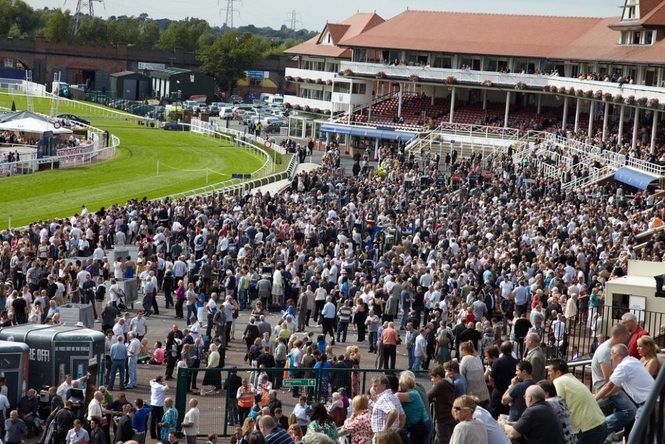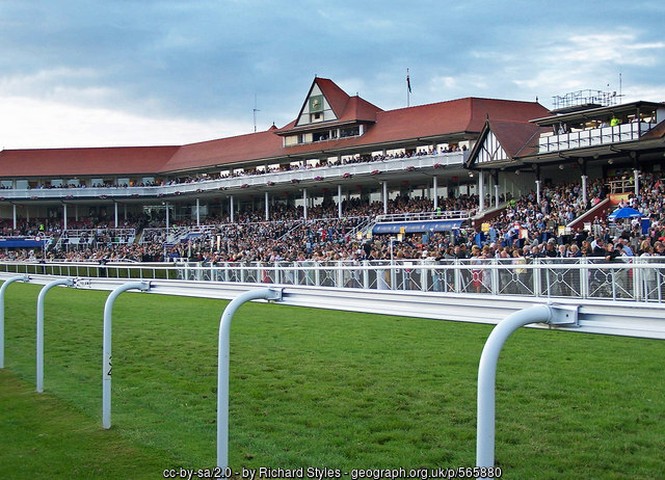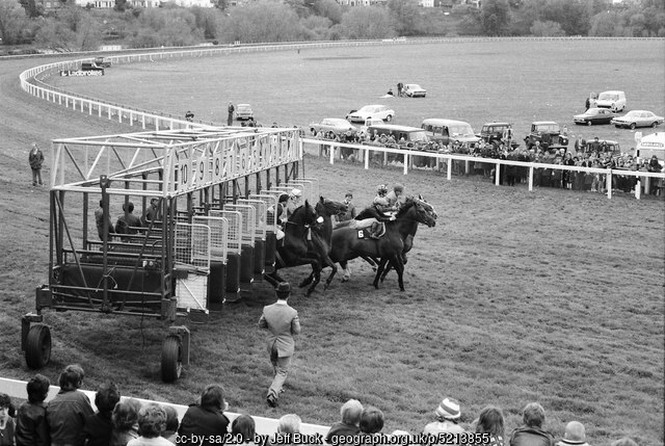Chester Racecourse Guide
Of the 60 racecourses spread over the British mainland, that which lies in the heart of Chester City centre is unique for a couple of reasons. Firstly, with the first meeting having taken place way back in 1539, the track is officially recognised by Guinness World Records as the world’s oldest operating track. The track’s second distinguishing feature comes in the course configuration, which more closely resembles a circle than any other British course.
A hugely popular track during the summer months thanks to a combination of high-class racing action, excellent atmosphere, and the course being frequently bathed in sunshine, Chester is a fine example of the phrase “an oldie, but a goodie”. Read on for more information on the track known as the “Roodee”.
Chester May Meeting

The majority of racecourses have their signature race days or meetings, and things are no different at this track on the banks of the River Dee. And at Chester the focal point of the season falls in May each year, with this excellent fixture which makes a big splash, not only locally, but also on the national stage. Planning a trip to Chester? This may well be the time to come.
What is the Chester May Meeting?
One of the earliest summertime highlights of the flat racing season, Chester’s May meeting is home to the track’s most famous contests, and attracts classy performers from both sides of the Irish Sea.
- The Chester May meeting takes place over three days, running from Wednesday through to Friday in early May each year.
- There are a total of 21 races held over the course of the meeting.
- Day One highlights include the Listed Class Cheshire Oaks and Group 3 Chester Vase.
- The Group 3 Ormnonde Stakes is the headline act on Day 2, supported by the Listed Class Dee Stakes.
- The closing Friday then features the track’s biggest handicap of the Chester Cup, and the high-quality Group 2 Huxley Stakes.
- There is plenty of variety on offer at this meeting, with events ranging from the 5f sprint contests, all the way up to the marathon 2m2½f of the Chester Cup.
- The meeting attracts a total of 50,000 racegoers over the course of the three days.
- Day 2 of the meeting is the track’s biggest “Ladies Day”, rarely failing to sell out and offering prizes for the best dressed ladies.
- Over £1million in total prize money is on offer over the course of the meeting’s 21 races.
Visiting Chester Races
Tempted by a visit to Chester’s Roodee track, either for the May feast or any of the other excellent fixtures on offer? Here’s all you need to know.
- Location – The course lies more or less slap bang in the heart of the walled cathedral city of Chester in Cheshire in Northwest England.
- Address – The Racecourse, Chester, Cheshire, CH1 2LY
- Contact details – enquiries@chester-races.com or 01244 304 600 or via Twitter on @ChesterRaces.
- Tickets – There a wide variety of ticketing options available at Chester, designed to cater for all tastes and budgets. See the track’s official website for full details.
- Dress code – There is no dress code in place in the Open Course area or Dee Stand, with non-offensive fancy dress being permitted. Smarter stipulations apply in other areas.
- Transport – Given its city centre location and the fact that it lies within a mile of the main train station, Chester is easy to reach by road and rail. Car Parking is available at the track at a cost of £8-£11.
- Accommodation – Again courtesy of its position in the heart of the city, there are a wide variety of accommodation options within walking distance of the course. Alternatively, many racegoers like to combine a visit to the track with a stay in nearby Liverpool.
- Hospitality – Chester provides a wide range of hospitality packages including restaurants, private boxes, and Festival Chalets. See the Chester website for full details.
- Food and Drink – All sections of the course feature their own food and drink options. Rest assured a pint will always be within easy reach at this summertime track.
Chester History
As the oldest track in the land, no course has quite so much history behind it as that of Chester, which is now incredibly edging ever closer to its 500th year of operation. The fact that the racecourse sits on a patch of land used as a Roman harbour during the Dark Ages, is a fine example of just how rich in history this area of the country is.
The track’s nickname actually harks back to Medieval times, as lying on a mound in the centre of the course is a small cross known as a “rood”. Roodee being a variation of the term “rood Eye” which translates to Island of the Cross. What does the cross signify you may ask? Allegedly it marks the burial place of a statue of the Virgin Mary which fell and killed Lady Trawst. Tried and found guilty of the crime by a jury of 12 men, the statue was sentenced to death by hanging. They certainly did things a little differently back in those days!
The End Of Violence: Racing Arrives
Moving away from the capital punishment of inanimate objects, and returning to the sporting world, the current site of the course later became the venue of the notorious Goteddsday football match – an event so bloody and violent that it was banned by the city council in 1533. Seeking a more civilised form of entertainment to keep the locals entertained, Chester Racecourse was born in 1539, with the first race taking place on the 5th February that year.
That 1539 contest wasn’t actually the first racing event ever to take place in Chester though. That honour belongs to a contest held as part of the Chester Fair of 1512 which, in handing out a hand-painted wooden spoon to winning connections, became the first horse race to award a prize to the winner. Not quite the $7.2million of a modern Dubai World Cup, but a prize, nonetheless. This early race was, however, to leave a mark which lingers on into the modern era by virtue of being organised by Mayor Henry Gee – the man who inspired the term “gee-gees” in reference to horse racing.
Steadily increasing in popularity over the years, the track began to become more organised and focussed upon providing an excellent race-day experience. Key dates in the 18th and 19th centuries including:
- 1766 – May Festival makes its debut.
- 1817 – First Grandstand opened.
- 1824 – First appearance of the Tradesman’s Cup – now the Chester Cup.
The Oldest Track in the Modern Era
Enjoying a relatively smooth passage from its ancient roots to becoming one of the UK’s most popular summertime tracks, Chester did experience adversity in 1985 when the main Grandstand was ruined following an arson attack. Undeterred by this setback, track officials set about promptly rebuilding the stand and followed this up with further improvements to facilities, including the opening of the 1539 restaurant in 2008, and the launch of the track’s in-house tote-stye betting platform, chesterBet in 2012, creating a historic track which offers a thoroughly modern experience.
Other Meetings & Races At Chester
The May meeting is undoubtedly the event for which the track is best known, regularly attracting the best of the handicappers in addition to runners who go on to contest the Classic contests of the Epsom Derby and Oaks later in the season.
However, it is not all about the three-day bonanza which annually kicks off the season at Chester, and there are a further 12 race days on offer between the months of May and October, with the following trio featuring amongst the highlights.
City Plate Day
Saturday afternoon fixtures held at the height of Summer are always likely to prove popular with racegoers, and sure enough City Plate Day at Chester doesn’t disappoint. Serving up a whole host of additional entertainment – including live music after racing – and an eclectic array of catering options, it is always very well attended. And then of course there is the racing itself, with the seven-race card being headlined by the 7f Listed Class contest of the City Plate that gives the meeting its name.
Autumn Festival
The second of the track’s multi-day meetings takes place towards the tail end of the season, with this two-day fixture held over a Friday and Saturday in early September. Handicapping fare is the order of the day on the seven-race Friday card, but things move up in class a little on the Saturday, with the Listed class Stand Cup over the 1m4½f trip taking centre stage.
Queensferry Stakes Day
The track’s only Sunday afternoon fixture of the season takes place in late July/early August each year and provides punters with another classy highlight in the shape of the Queensferry Stakes. That 6f event for those sprinters verging on Group class serves as the centrepiece at a seven-race fixture, which also doubles as the track’s family fun day, creating an occasion to keep racegoers of all ages entertained.
Biggest Races at Chester
For a track which only stages around 15 meetings per year, Chester crams a fair amount of quality into those fixtures, with the following list highlighting the standout events of the year.
- Chester Cup, May Meeting – Handicap, 2m2f147y
- Huxley Stakes, May Meeting – Group 2, 1m2f75y
- Chester Vase, May Meeting – Group 3, 1m4f66y
- Ormonde Stakes, May Meeting – Group 3, 1m5f89y
- Dee Stakes, May Meeting – Listed, 1m2f75y
- Cheshire Oaks, May Meeting – Listed, 1m3f79y
- Stand Cup, Autumn Festival – Listed, 1m4f63y
- City Plate, August -Listed, 7f
- Queensferry Stakes, July/August – Listed, 6f17y
The Track
Widely recognised as being just about the tightest course in all of British or Irish racing, Chester’s almost circular circuit is one of the shorter ones and measures only around 1m in length. As a result, runners are veering left-handed for almost the entirety of their journey – even contests over the minimum 5f trip being on the turn for close to 60% of the distance. Some respite from the bends does arrive in the shape of the 2f home straight, but any animal with balance issues will likely run into serious problems around here.
Given the configuration of the track, it will be no surprise to learn that a low draw against the inside rail is an advantage over all distances. Extremely strong in 5f and 5½f events, this bias does still exist over middle distances. Whatever the trip, runners drawn on the outside are up against it, and the bigger the size of the field, the bigger this disadvantage becomes. Unless able to get a real flier from the stalls, high drawn runners will be faced with the option of having to sit and suffer behind a wall of runners or being trapped out wide and covering additional distance.
Other than the draw, the next most important aspect to look for at this track are runners who like to lead, or at least race right up with the pace. Given that almost continually turning nature, those getting to the lead can prove very tough to peg back due to the difficulties in overtaking around a bend. Find a low drawn runner, who is quick from the stalls, and likes to make the running, and you may well be onto a winner.
If there is a time to place a little less weight on the draw, it is when the ground is riding soft or heavy. Many runners do tire in the home straight under such conditions and may be picked off by those coming from behind. In addition, in heavy conditions the faster strip of ground is often found up the stands side rail in the straight, resulting in jockeys steering their mounts across the track and negating that low draw edge to a degree.




